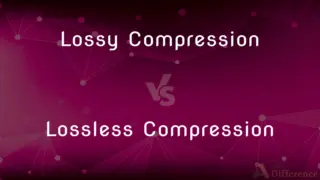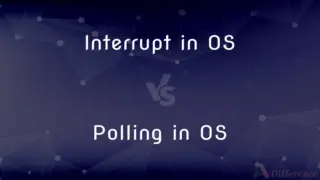Cross Pollination vs. Self Pollination — What's the Difference?
By Tayyaba Rehman & Urooj Arif — Published on February 3, 2024
Cross pollination involves transfer of pollen between different plants, promoting genetic diversity, while self pollination occurs within the same plant, ensuring reproductive success but limited diversity.

Difference Between Cross Pollination and Self Pollination
Table of Contents
ADVERTISEMENT
Key Differences
Cross pollination involves the transfer of pollen from the anther of one plant to the stigma of another, facilitating genetic diversity. Self pollination occurs when pollen from the anther of a plant is transferred to the stigma of the same plant or another flower on the same plant, promoting reproductive assurance but limiting genetic variation.
In cross pollination, pollen is often transferred by external agents like insects, wind, or animals, making it an agent-dependent process that enhances the gene pool of the offspring. Conversely, self pollination does not rely on external agents, as it can occur within a single flower or between flowers of the same plant, leading to offspring genetically identical to the parent.
Cross pollination is predominant in plants with unisexual flowers or those that have mechanisms to prevent self pollination, promoting biodiversity and adaptability. Self pollination is common in plants that have limited access to pollinators or in stable environments where maintaining a successful genotype is advantageous.
Plants adapted for cross pollination often exhibit features like brightly colored flowers, nectar, and scent to attract pollinators. Self pollinating plants may exhibit less pronounced floral features, as attracting pollinators is not a necessity for their reproduction.
Cross pollination can sometimes lead to hybrid vigor, where the offspring have better growth, resistance to disease, and fertility. Self pollination, while ensuring a stable population, may lead to inbreeding depression, where genetic defects become more pronounced over generations.
ADVERTISEMENT
Comparison Chart
Pollen Transfer
Between different plants
Within the same plant
Dependency on External Agents
Often dependent on agents like insects, wind, animals
Generally independent of external agents
Genetic Diversity
Promotes genetic variation and adaptability
Limits genetic variation, offspring are genetically similar
Floral Characteristics
Brightly colored, scented flowers to attract pollinators
Less pronounced floral features
Outcome
Can lead to hybrid vigor
May lead to inbreeding depression
Compare with Definitions
Cross Pollination
A method enhancing genetic diversity in plants.
Cross pollination in the wildflower meadow results in a variety of vibrant blooms.
Self Pollination
A method ensuring plant reproduction without external agents.
In isolated environments, self pollination guarantees the continuation of certain plant species.
Cross Pollination
Pollination involving two separate plants.
Wind aids in cross pollination by dispersing pollen between plants.
Self Pollination
Pollination leading to limited genetic variation.
Self pollination in certain flowers results in less diverse plant populations.
Cross Pollination
Key to hybridization in plants.
Gardeners often rely on cross pollination to develop new plant varieties.
Self Pollination
Adaptation to environments with scarce pollinators.
In harsh climates, self pollination is a survival strategy for some plants.
Cross Pollination
Transfer of pollen between different plants.
Bees play a crucial role in cross pollination, transferring pollen from one flower to another.
Self Pollination
Occurs in plants with bisexual flowers.
Tomatoes are capable of self pollination due to their flower structure.
Cross Pollination
A process often facilitated by pollinators.
Butterflies are vital agents of cross pollination in many ecosystems.
Self Pollination
Pollen transfer within the same plant.
Pea plants often exhibit self pollination, leading to identical offspring.
Cross Pollination
The transfer of pollen from an anther of a flower of one plant to a stigma of a flower of another plant of the same species. Also called allogamy, xenogamy.
Self Pollination
The transfer of pollen from an anther to a stigma of the same flower; autogamy.
Cross Pollination
Influence or inspiration between or among diverse elements
"Jazz is fundamentally the cross-pollination of individual musicians playing together and against each other in small groups" (Ralph de Toledano).
Self Pollination
The transfer of pollen from an anther of one flower to a stigma of another flower on the same plant; geitonogamy.
Cross Pollination
(botany) fertilization by the transfer of pollen from an anther of one plant to a stigma of another.
Self Pollination
Pollination of a flower by its own pollen, in a flower that has both stamens and a pistil.
Cross Pollination
(figurative) inspiration, stimulation, or influence between diverse elements.
Self Pollination
Fertilization by transfer of pollen from the anthers to the stigma of the same flower
Cross Pollination
Fertilization by transfer of pollen from the anthers of one flower to the stigma of another.
Cross Pollination
Fertilization by transfer of pollen from the anthers of one flower to the stigma of another
Cross Pollination
Stimulating influence among diverse elements;
The cross-pollination of the arts
Common Curiosities
Can cross pollination occur between different species?
Yes, leading to hybrid species with traits from both parent plants.
What is the main advantage of cross pollination?
It promotes genetic diversity and adaptability in plant species.
Can self pollination lead to weaker plants?
Yes, due to inbreeding depression and lack of genetic diversity.
Are there any specific adaptations in plants for self pollination?
Yes, such as the proximity of male and female reproductive parts.
Is self pollination more common in certain environments?
Yes, especially in stable, isolated, or harsh environments.
How do plants prevent self pollination if they are capable of cross pollination?
Through mechanisms like different maturation times for male and female parts.
What is a key characteristic of flowers adapted to cross pollination?
They are often bright and fragrant to attract pollinators.
Why do some plants prefer self pollination?
To ensure reproductive success in environments lacking reliable pollinators.
Can human intervention aid in cross pollination?
Yes, especially in controlled agricultural and horticultural practices.
Can self pollination happen in wind-pollinated plants?
Yes, if the pollen falls on the stigma of the same plant.
Is cross pollination essential for fruit production?
In many plants, yes, as it leads to fertilization and fruit formation.
Are there environmental benefits to cross pollination?
Yes, it contributes to the biodiversity and resilience of ecosystems.
What role do insects play in cross pollination?
They often act as carriers of pollen between plants.
How does self pollination affect plant evolution?
It can limit evolutionary change due to reduced genetic variation.
Do all plants have the capability for self pollination?
No, some are exclusively adapted for cross pollination.
Share Your Discovery

Previous Comparison
Lossy Compression vs. Lossless Compression
Next Comparison
Interrupt in OS vs. Polling in OSAuthor Spotlight
Written by
Tayyaba RehmanTayyaba Rehman is a distinguished writer, currently serving as a primary contributor to askdifference.com. As a researcher in semantics and etymology, Tayyaba's passion for the complexity of languages and their distinctions has found a perfect home on the platform. Tayyaba delves into the intricacies of language, distinguishing between commonly confused words and phrases, thereby providing clarity for readers worldwide.
Co-written by
Urooj ArifUrooj is a skilled content writer at Ask Difference, known for her exceptional ability to simplify complex topics into engaging and informative content. With a passion for research and a flair for clear, concise writing, she consistently delivers articles that resonate with our diverse audience.













































